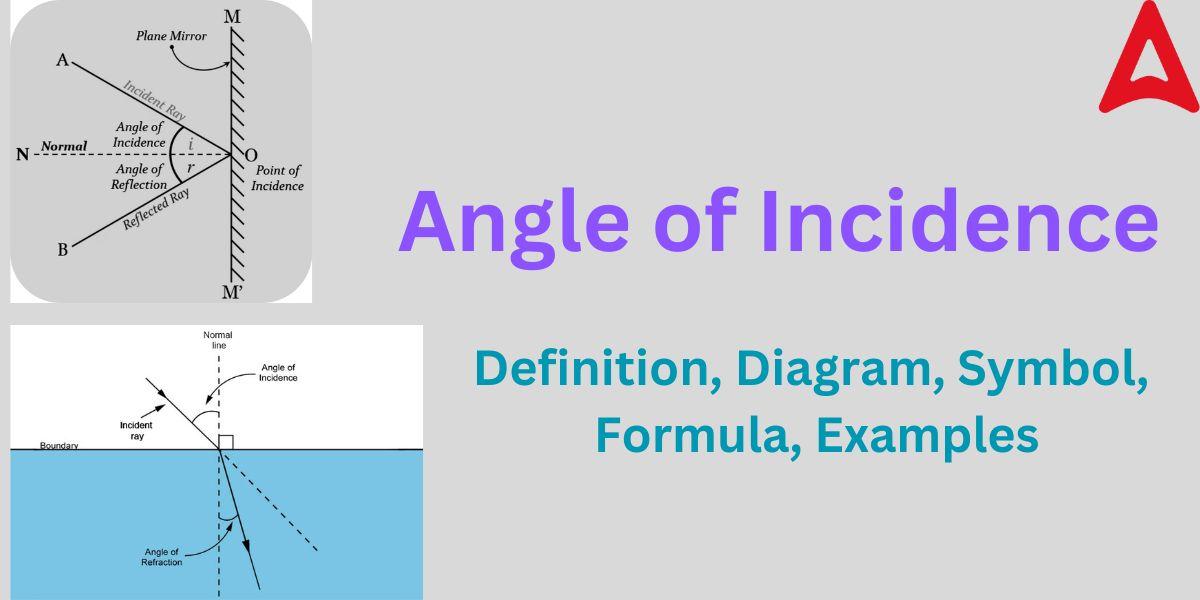The angle of incidence, also known as the incidence angle or the incident angle, is a phenomenon associated with the optics domain of physics. When a ray of light meets the boundary of another medium, it may undergo reflection or refraction, depending on the nature of the other medium. The opaque medium causes the light to reflect back to the same medium, hence the reflection of light takes place in this case. If the other medium is transparent or translucent, then the light enters the other medium and bends from its original path, causing the refraction process. In both cases, the this angle plays a major role in determining the path of light waves. Let us dive deep into this interesting topic and understand this special angle in detail.
Angle of Incidence
Meaning of Angle of Incidence
The angle of incidence is a major phenomenon that help us understand and predict the behavior of light. Have you ever played with the rubber ball by throwing it on the wall? If you have done so, you must have noticed that if you throw the ball at different angles, the ball bounces back through different path. The same analogy can be applied to understand the incidence angle. The light when strikes the boundary of two mediums, it changes its path depending on the angle at which it strikes the boundary. That particular angle is known to be the incidence angle. Let us understand it through its definition and a diagram.
Angle of Incidence Definition
The angle of incidence is the angle formed between the incident ray and the normal at the point where the ray strikes. Normal is basically an imaginary perpendicular line passing through the point of incidence, i.e., the point at which the light ray strikes. In other words, the angle that the incident ray makes with the perpendicular of the boundary where the light ray strikes is known as the angle of incidence. It is a fundamental idea in physics and optics, and is essential to many disciplines including astronomy, photography, and engineering. Although primarily used in the domain of optics, the incidence angle plays a critical role in determining how waves interact with surfaces, whether dealing with light, sound, or other types of waves too.
Angle of Incidence Diagram
The diagram given below will help you understand this special angle in a more better way. The diagram of this angle is shown below:

As shown in the above diagram, a light ray is incident on the surface at p
So, p is the point of incidence
N is the normal (perpendicular to the surface from the point of incidence)
“i” is the incidence angle
Angle of Incidence Symbol Notation
The symbol notation of a physical quantity help to remove the ambiguity and provide consistency in recognizing the physical quantity. It is important to know the symbol notation of the incidence angle from the examination point of view. The examiner often plays with the mind of students by not mentioning the complete name and giving only the symbol of that particular quantity. The symbol notation for this special angle will help students of class 10 and class 12 in their board examination. The angle of incidence is denoted by “i” or θi.
Angle of Incidence in Reflection
As we know, reflection takes place when a light ray strikes the boundary of an opaque medium. The angle made by light with the normal of the opaque surface at the point of incidence is known as the angle of incidence. The incidence angle in reflection plays a crucial role in determining the path of light after reflection. In simple words, the angle of reflection (the angle made by reflected ray with respect to the normal) depends on the incident angle. For a plain surface like a plain mirror, the incidence angle will always be equal to the angle of reflection. Mathematically,
i = r
where, i = incidence angle
r = angle of reflection
The relationship of incidence angle = angle of reflection is shown in the following diagram.

Angle of Incidence in Refraction
As stated earlier, the concept of angle of incidence is observed both in refraction and refection of light. Whenever, the light rays strike the boundary of two mediums, this angle is formed along with the normal of the boundary. Let us observe the concept of incidence angle in refraction through a diagram.

As we can observe in the above diagram, a light ray is incident at the boundary of two medium and it changes it path in the other medium.
Here, incidence angle = i
angle of refraction = r
It is important to note that the incidence angle is generally not equal to angle of refraction.
Angle of Incidence Formula
The value of the incident angle can be derived using its formula. As the behavior of the incidence angle in reflection and refraction differs, so different formula is used in each case. Let us learn the formula related to this special angle in both these cases
Angle of Incidence Formula in Reflection
The angle of incidence formula in reflection is given by:
i = r
where, i = incidence angle
r = angle of reflection
This formula is valid only if the surface in consideration is flat, such as a plain mirror. So, the above formula is also known as the reflection formula in a mirror.
Angle of Incidence Formula in Refraction
The incidence angle relates to the angle of refraction and the refractive index of two mediums in the refraction phenomenon. This formula is derived using the Snell’s law.
The angle of incidence formula in refraction is given by:
Sin i/Sin r = n2/n1
where, i = incidence angle
r = angle of refraction
n1 = refractive index of the incident medium
n2 = refractive index of the refracted medium
Angle of Incidence Examples
After learning the concept, it is always advised to practice some solved questions to have a better understanding of the learned topic. So, we have provided some solved examples on this topic for a better understanding of this concept.
Example 1: The ray of light strikes a plain mirror and gets reflected by 40°. At what angle, the ray of light must have struck the mirror?
Solution: As the angle of reflection is given to be 40°
We know, incidence angle = reflected angle in a plain mirror
So, incidence angle = 40°
Hence, the light struck the mirror at 40°
Example 2: A light gets refracted by 60° when travelling from a medium of refractive index 2 to the medium of refractive index Y. It is given that the incident angle is 30°. Find out the value of Y.
Solution: As we have been given the angle of refraction “r” = 60°
angle of incidence “i” = 30°
refractive index of the incident medium (n1) = 2
refractive index of refracted medium (n2) = Y
By using the formula:
Sin i/Sin r = n2/n1
and putting all the given values in the aforementioned equation, we get
Sin30°/Sin60° = Y/2
(1/2)/(√3/2) = Y/2
1/√3 = Y/2
Y = 2/√3
Hence, the refractive index of the other medium = 2/√3
Example 3: The angle between the reflected ray and the incident ray is 90°. What will be the value of the incidence angle?
Solution: Given, incidence angle + angle of reflection = 90°
as we know, incidence angle= angle of reflection (in reflection process)
So, incidence angle + incidence angle= 90°
2 x incidence angle = 90°
incidence angle = 90°/2
Therefore, incidence angle = 45°









 Try CUET College Predictor 2025 to Predi...
Try CUET College Predictor 2025 to Predi...
 CUET Result 2025 OUT (Today) @cuet.nta.n...
CUET Result 2025 OUT (Today) @cuet.nta.n...
 Why the Delay in CUET UG 2025 Results? C...
Why the Delay in CUET UG 2025 Results? C...









